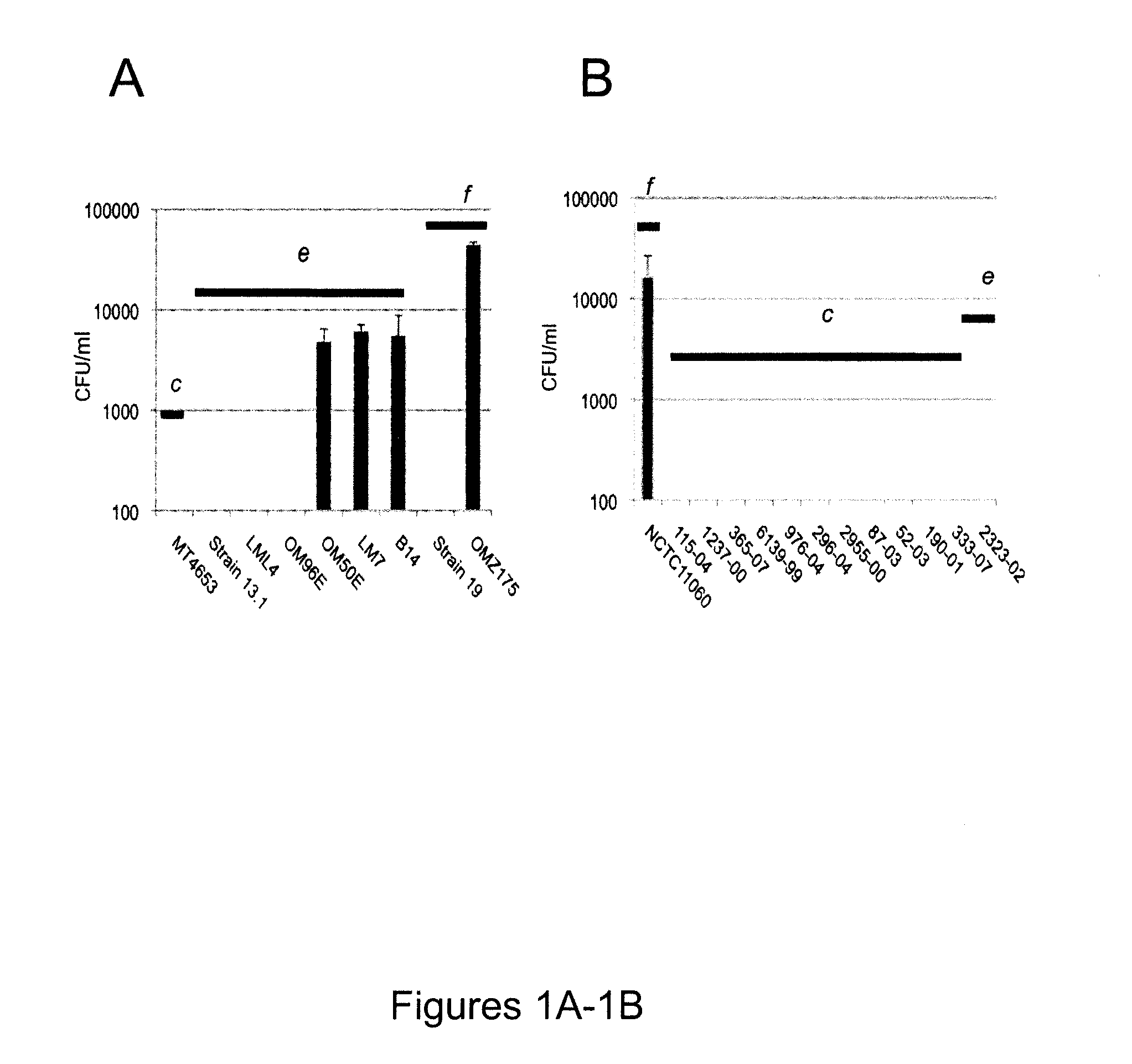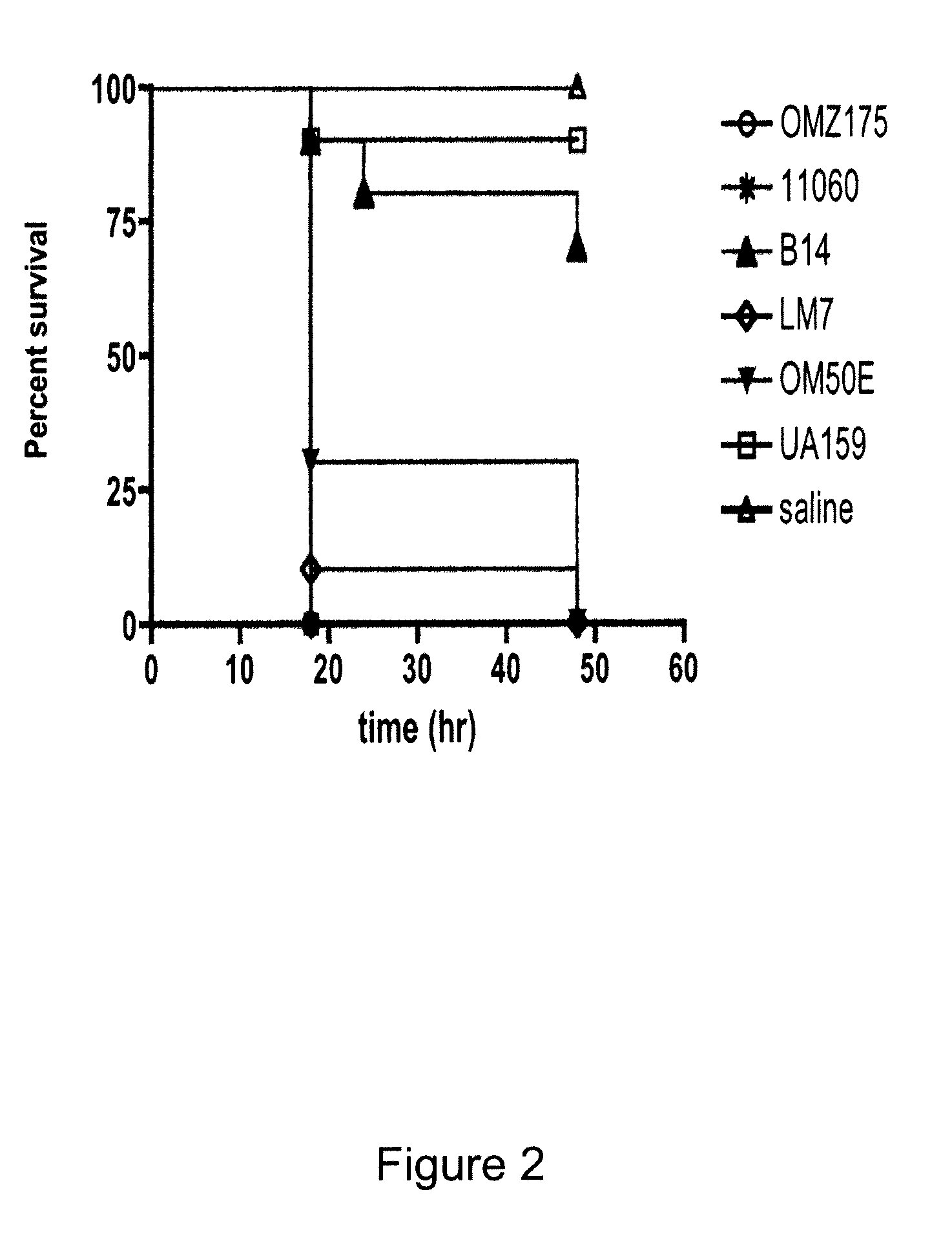Method for predicting and preventing cardiovascular disease
a cardiovascular disease and vascular disease technology, applied in the field of predicting and preventing cardiovascular disease, can solve the problems of lack of evidence of cell invasion in vivo, and achieve the effects of preventing cardiovascular disease, preventing cardiovascular disease, and increasing virulen
- Summary
- Abstract
- Description
- Claims
- Application Information
AI Technical Summary
Benefits of technology
Problems solved by technology
Method used
Image
Examples
example 1
Identification of New Invasive Strains Supports the Link Between Serotypes e and f and Invasive Behavior
[0092]In a previous study, strains B14 and OMZ175, belonging to serotypes e and f, respectively, were able to invade HCAEC in vitro, whereas none of the 8 serotype c strains tested displayed an invasive behavior (Abranches et al., “Invasion of Human Coronary Artery Endothelial Cells by Streptococcus mutans OMZ175,”Oral Microbiol Immunol 24:141-5 (2009), which is hereby incorporated by reference in its entirety). To increase the number of serotype e and f strains screened, the capacity of 19 additional strains to invade HCAEC were assessed; 12 isolated from the blood of patients with bacteremia and / or IE (10 serotype c, 1 serotype e, and 1 serotype f), and 7 isolated from dental plaque (1 serotype c, 4 serotype e, and 2 serotype f). OMZ175 and B14 were used as controls for high and low invasive rates in these experiments. Of the strains isolated from dental plaque, two serotype e s...
example 2
Invasive Strains Are More Virulent Than Non-invasive Strains in the Greater Wax Worm Model
[0093]Whether G. mellonella could be used to identify differences in the virulence potential of invasive and non-invasive strains was examined. With the exception of the serotype e B14 strain, a significantly higher mortality rate (P<0.01) was found in the groups of worms infected with invasive strains (70-100% mortality) within the first 48 h. In contrast, only 10% of the larvae infected with non-invasive serotype c UA159 died over the same period of time (FIG. 2). Six additional non-invasive strains belonging to serotypes c (52-03, 2955-00, 190-01 and GS-5), e (2323-02) and f (strain19) were tested in this model and all behaved similarly to UA159.
example 3
Invasive Strains Carry and Express the cnm Gene
[0094]Recently, it was demonstrated that 10-20% of S. mutans strains isolated in Asia and Europe carried the cnm gene, which encodes for a collagen and laminin-binding protein (Nakano et al., “Molecular Characterization of Streptococcus mutans Strains Containing the cnm Gene Encoding a Collagen-binding Adhesin,”Arch Oral Biol 55:34-39 (2010); Nomura et al., “Molecular and Clinical Analyses of the Gene Encoding the Collagen-Binding Adhesin of Streptococcus mutans,” J Med Microbiol 58:469-75 (2009), each of which is hereby incorporated by reference in its entirety). Notably, this gene is associated predominantly with serotypes f and k, and rarely found in serotype c and serotype e (Nakano et al., “Molecular Characterization of Streptococcus mutans Strains Containing the cnm Gene Encoding a Collagen-binding Adhesin,”Arch Oral Biol 55:34-39 (2010); Nomura et al., “Molecular and Clinical Analyses of the Gene Encoding the Collagen-Binding Adh...
PUM
| Property | Measurement | Unit |
|---|---|---|
| sub-inhibitory concentration | aaaaa | aaaaa |
| pH | aaaaa | aaaaa |
| weight | aaaaa | aaaaa |
Abstract
Description
Claims
Application Information
 Login to View More
Login to View More - R&D
- Intellectual Property
- Life Sciences
- Materials
- Tech Scout
- Unparalleled Data Quality
- Higher Quality Content
- 60% Fewer Hallucinations
Browse by: Latest US Patents, China's latest patents, Technical Efficacy Thesaurus, Application Domain, Technology Topic, Popular Technical Reports.
© 2025 PatSnap. All rights reserved.Legal|Privacy policy|Modern Slavery Act Transparency Statement|Sitemap|About US| Contact US: help@patsnap.com



